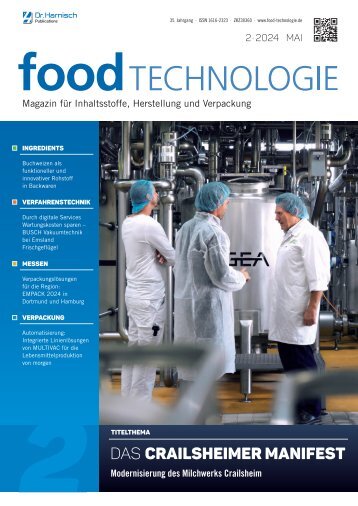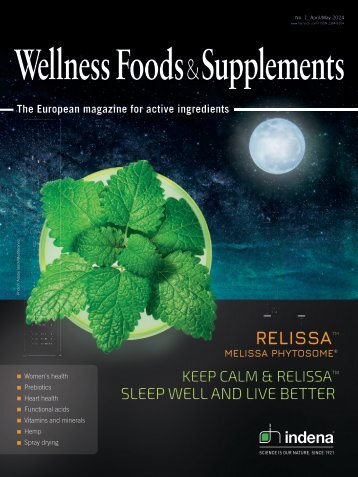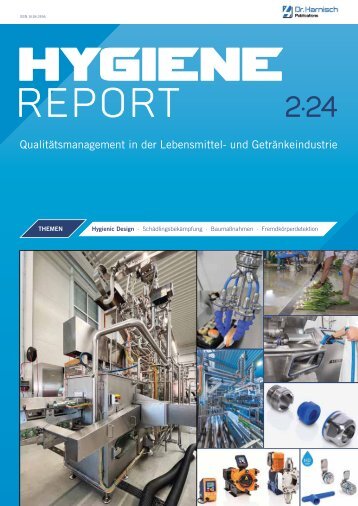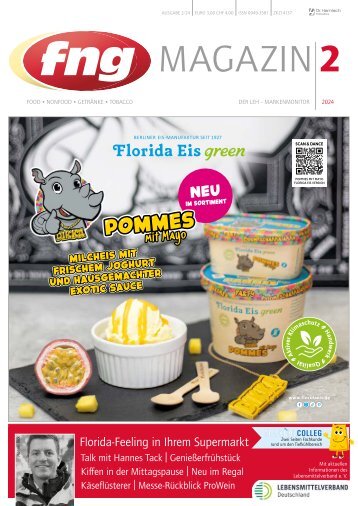Wellness Foods & Supplements 3/2020
- Text
- Harnischcom
- Supplements
- Foods
- Wellness
- Clinical
- Salts
- Protein
- Dairy
- Vaginal
- Products
- Yogurt
- Mineral
- Calcium
- Magnesium
Fortified dairy
Fortified dairy alternatives Mineral fortification in dairy alternatives Dr. Sabrina Fischer and Miriam Feja Introduction Dairy products are considered healthy because they provide the body with minerals and vitamins. Fermented milk products such as yoghurt are excellent sources of protein, calcium, phosphorus, riboflavin, thiamine, vitamin B12, folate, niacin, magnesium and zinc. They also have a positive image because the probiotics they contain have a beneficial effect on the immune system, as demonstrated by various studies. 1 Nevertheless, an increasing number of people cannot or do not want to consume milk products. The reasons range from ecological and animal welfare concerns, to health aspects such as cow’s milk allergies, lactose intolerance, concerns around calorie intake and preventing high cholesterol. 2,3 Plant-based alternatives are therefore becoming increasingly important, and producers are facing the challenge of developing products that are as close as possible to cow’s milk in terms of taste, appearance, stability and nutritional value. Plant-based milk alternatives and yoghurts Plant-based milk alternatives are liquids that consist of plant proteins homogenised in water, often together with emulsifiers, stabilisers, oil, sugar, salt and flavours to imitate the appearance and consistency of cow’s milk. 2 Soy is still the most commonly used source of protein for plant-based drinks and yoghurts, followed by coconut, almonds and oats. In recent years, a large number of new plant-based sources of protein have entered the market, such as nuts (cashews, hazelnuts and walnuts), rice, peas, lupine and hemp. These sources of protein differ widely in terms of nutritional value, mineral profile and amino acid profile – as well as in terms of taste. 32 No. 3 November/December 2020
Fortified dairy alternatives Indeed, some plant-based raw materials give rise to unpleasant taste profiles (e. g. bitter, green or beany notes), and therefore present a major challenge for manufacturers looking to produce a pleasanttasting product. Plant-based yoghurts can be produced in the same way as traditional yoghurts, employing fermentation with lactic acid-producing bacteria such as Bifidobacterium and Lactobacillus. 3 It may also be necessary to add sugars for the fermentation process, depending on the raw material used. The advantage of this process is that non-dairy yoghurts also contain living cultures. However, they still lack the vitamins and the minerals, especially calcium, found in cow’s milk-based products. 4 Mineral fortification and health claims While calcium enrichment of soy drink has become relatively common, enrichment with other minerals and vitamins is still rare. Added minerals in plant-based yoghurts are also uncommon, even though fortification offers an additional opportunity for promoting health benefits. Minerals such as calcium, magnesium, potassium and zinc in particular allow many health claims besides bone health, addressing topics such as immunity, muscle function or energy (in line with the rules on health claims under Regulation (EC) No 1924/2006). Table 1: Overview of common mineral salts approved for fortification in Europe. 5 Organic salts are marked in bold, and salts offered by Jungbunzlauer are marked in blue. that organic mineral salts have higher bioavailability than inorganic ones. 6–8 Jungbunzlauer offers a wide range of organic mineral salts in different granulation grades. These are suitable for fortification of various food matrices and are well established in the dairy industry. Calcium is important for healthy bones Calcium is one of the most important modifiable dietary factors for normal bone development and maintaining bone mass in old age. About 99 % of the calcium contained in the human body is stored in the bones in the form of calcium hydroxyapatite. The amount of calcium present influences peak bone mass. 9 Multiple studies have shown that insufficient calcium intake is associated with an increased risk of osteoporosis and related fractures. 9–11 As well as calcium, other minerals such as magnesium, zinc and vitamin D are crucial for healthy bones. 6 However, there are still many people whose calcium intake is inadequate. The USDA Advisory Committee’s 2020 scientific report states that 44 % of Americans are at risk of calcium inadequacy. 12 Solubility and bioavailability of different mineral salts The addition of minerals to complex food matrices is often challenging and the right choice of mineral salts is crucial to success. Mineral salts can be broadly divided into soluble and insoluble salts. Whereas soluble salts have an influence on pH and taste, insoluble salts can lead to a sandy mouthfeel and sedimentation. Mineral salts can also be divided into organic and inorganic salts. Organic mineral salts are salts of naturally occurring acids, such as citric acid or lactic acid. They usually have a more neutral taste than inorganic mineral salts. In addition, various studies indicate No. 3 November/December 2020 33
- Seite 1: No. 3, November/December 2020 www.h
- Seite 4 und 5: Contents Health Convenience Food Fo
- Seite 6 und 7: Oils and fats Photo © : 123rf/jirk
- Seite 8 und 9: Oils and fats sive “key figure”
- Seite 10 und 11: Functional sugars Photo © : Jennew
- Seite 12 und 13: Nutrition and ageing Photo © : Ado
- Seite 14 und 15: Nutrition and ageing demineralizati
- Seite 16 und 17: Nutrition and ageing Proferrin ® ,
- Seite 18 und 19: Energy and endurance system is conn
- Seite 20 und 21: Minerals Photo ® : Adobe Stock/nd3
- Seite 22 und 23: Minerals Health Claims Magnesium co
- Seite 24 und 25: Women‘s health Probiotics for wom
- Seite 26 und 27: Women‘s health How can oral probi
- Seite 28 und 29: Clinical trials Photo ® : Adobe St
- Seite 30 und 31: Clinical trials methods; and the sa
- Seite 34 und 35: Fortified dairy alternatives Dairy
- Seite 36 und 37: Fortified dairy alternatives theref
- Seite 38 und 39: Fortified dairy alternatives instea
- Seite 40 und 41: Dairy products lactose digestion”
- Seite 42 und 43: Dairy products EPILAC premium yogur
- Seite 44: Come and see for yourself: www.harn
Unangemessen
Laden...
Magazin per E-Mail verschicken
Laden...
Einbetten
Laden...




























































































































































































































































































